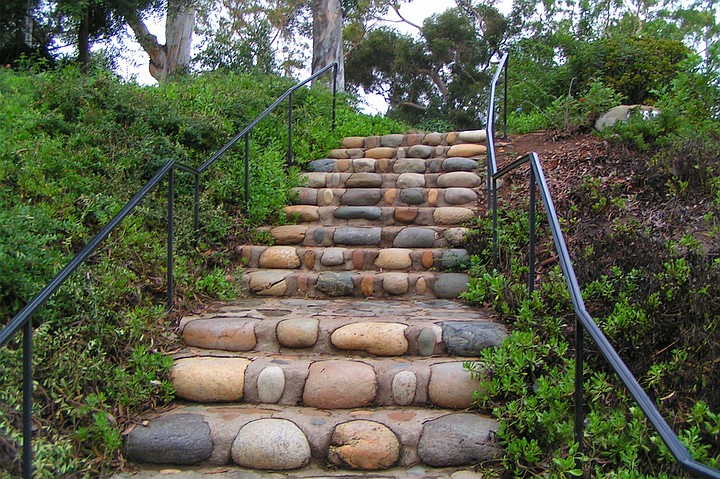 Facebook
Facebook
 X
X
 Instagram
Instagram
 TikTok
TikTok
 Youtube
Youtube

A project proposed for Presidio Park would make the historic Junipero Serra Museum more accessible to visitors with disabilities - but archeologists are afraid it will harm a site still in discovery.
"Only about one-third of the Presidio quarters have been archaeologically investigated and mapped," says Paul Chace, Ph.D., a local archaeologist who has spent years advocating for the former military fort.

The Presidio, which sits just above historic Old Town at 2811 Jackson Street, marks the site of the first white settlement on the U.S. West Coast. Soldiers and priests built it in 1769 on the territory of the indigenous Kumeyaay Indians; its remains are the key portion of the city-owned park.
Today, the park on a hill has an accessibility problem. Uneven terrain and endless steps pose a challenge to many visitors. In recent months, restoration was completed on the Serra Museum, which was built in 1929 and is owned by the San Diego History Center. But nothing was done to boost access to the building.
Both the Serra Museum and Presidio site remain inaccessible to those with physical disabilities, notes the city's website. A project to finish the original road for access behind the museum was never completed. However, the city is making plans to remove those barriers.

The project, known as the Junipero Serra Museum ADA Improvement, is currently being scheduled for 2023-2024. The changes may include a new parking lot, security lighting, walkways and/or accessible ramps, site furnishings, and landscape enhancements, at a total cost of $2,809,787.
Ongoing, operational costs will be determined "as the project is refined and all amenities and unique site characteristics are considered."
Chace says the handicapped parking would require about five acres of the presidio site to be bulldozed downward to create a new parking pad, in the process disturbing a registered national historic landmark that remains a mystery.
There's the large, never-explored mound representing the Presidio Commandante’s residence, as well as several cannon bastions, the 1792 gun battery, and a separate armory for storing munitions that has yet to be located, he says.
Also proposed is the widening of the narrow Presidio Drive for emergency vehicles, which would smash through the landmark, destroying preserved walls and other buried features.
In addition, the project may clash with a large underground fort on the site, complete with walls, bastions, chapels and a cemetery. Chace isn't the only one saying the Presidio needs to be better studied and the project modified, or a full Environmental Impact Report prepared.
The city's new Parks Master Plan includes a goal to develop master plans for its National Historic Landmark parks.


A project proposed for Presidio Park would make the historic Junipero Serra Museum more accessible to visitors with disabilities - but archeologists are afraid it will harm a site still in discovery.
"Only about one-third of the Presidio quarters have been archaeologically investigated and mapped," says Paul Chace, Ph.D., a local archaeologist who has spent years advocating for the former military fort.

The Presidio, which sits just above historic Old Town at 2811 Jackson Street, marks the site of the first white settlement on the U.S. West Coast. Soldiers and priests built it in 1769 on the territory of the indigenous Kumeyaay Indians; its remains are the key portion of the city-owned park.
Today, the park on a hill has an accessibility problem. Uneven terrain and endless steps pose a challenge to many visitors. In recent months, restoration was completed on the Serra Museum, which was built in 1929 and is owned by the San Diego History Center. But nothing was done to boost access to the building.
Both the Serra Museum and Presidio site remain inaccessible to those with physical disabilities, notes the city's website. A project to finish the original road for access behind the museum was never completed. However, the city is making plans to remove those barriers.

The project, known as the Junipero Serra Museum ADA Improvement, is currently being scheduled for 2023-2024. The changes may include a new parking lot, security lighting, walkways and/or accessible ramps, site furnishings, and landscape enhancements, at a total cost of $2,809,787.
Ongoing, operational costs will be determined "as the project is refined and all amenities and unique site characteristics are considered."
Chace says the handicapped parking would require about five acres of the presidio site to be bulldozed downward to create a new parking pad, in the process disturbing a registered national historic landmark that remains a mystery.
There's the large, never-explored mound representing the Presidio Commandante’s residence, as well as several cannon bastions, the 1792 gun battery, and a separate armory for storing munitions that has yet to be located, he says.
Also proposed is the widening of the narrow Presidio Drive for emergency vehicles, which would smash through the landmark, destroying preserved walls and other buried features.
In addition, the project may clash with a large underground fort on the site, complete with walls, bastions, chapels and a cemetery. Chace isn't the only one saying the Presidio needs to be better studied and the project modified, or a full Environmental Impact Report prepared.
The city's new Parks Master Plan includes a goal to develop master plans for its National Historic Landmark parks.
Comments